Overview of the OCZ Trion 100 SSD
Penetration of solid-state drives in the lower sectors of the market is tight, and the reason for this is the significant price of electronic stuffing. There are those who have more than enough cheap 128-gigabyte models on SandForce from a little-known manufacturer, but this will not suit everybody. To reveal all the advantages, SSD needs a controller that can work effectively not only on streaming read / write operations, and the volume is normal, so that you can install two or three large software packages or modern games next to Windows and Office.
The current company OCZ (more precisely, Toshiba's OCZ), like the previous company OCZ, considers the market one of the main drivers for itself, and therefore regularly updates its product line. Not so long ago (by universal standards), the budget model OCZ Trion entered the market in four varieties - 120, 240, 480 and 960 gigabytes.
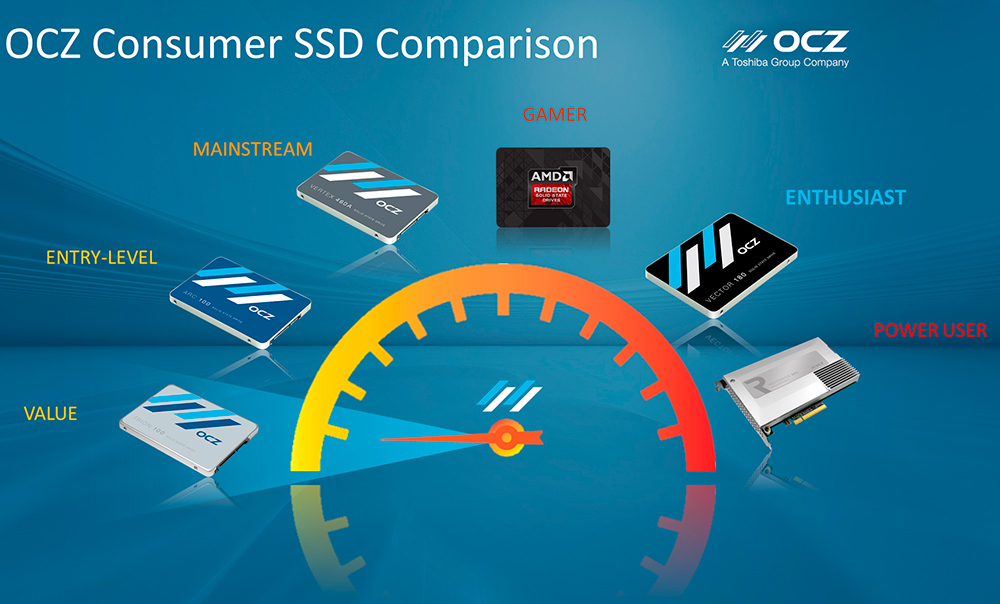
At prices option interesting: 3800, 6000, 12000 and 21000 rubles, respectively. At the time of writing this review (February 17), this is one of the cheapest SSD form factor 2.5 ″. The most profitable model is 240 GB: the most current volume (the golden mean between the toad and the needs), the second most expensive in its class. An excellent reason to consider it in more detail.
')
A Trion 100 drive (model TRN100-25SAT3-240G) is supplied in a thin cardboard box; I would even call it an envelope for a small box stiffness.

Inside a transparent plastic holder, a brief accompanying abstract and nothing more. No frame adapter to be installed in the 3.5 "compartment, no fastening screws.
Saving on accessories is justified when the struggle is for every cent. After assembling the case, there are always some screws with a suitable thread, and even without an adapter you can do.
The SSD case is not made of plastic (as in some other budget drives), but of extruded aluminum with a thickness of 0.8 mm, which, among other things, protects the electronic filling from mechanical damage. On the front side of the label indicating the model ...
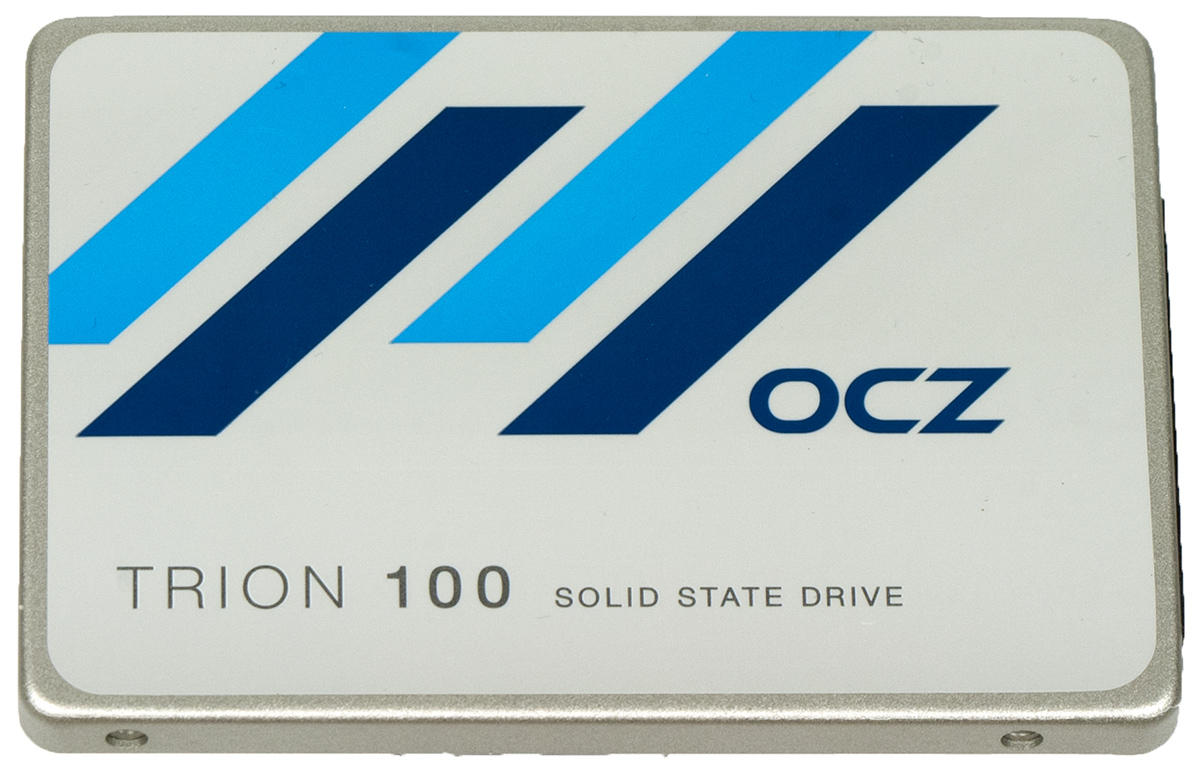
... On the back - a sticker with other useful information.
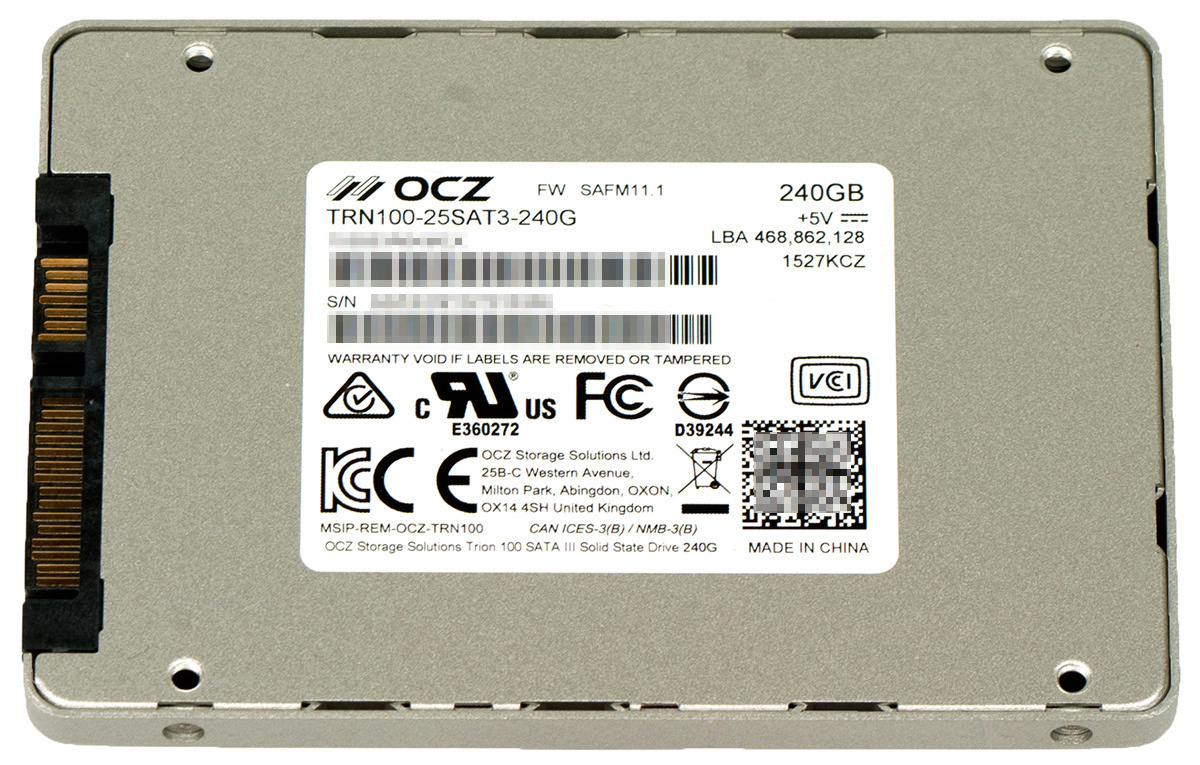
The thickness of the Trion 100 is standard - seven millimeters.
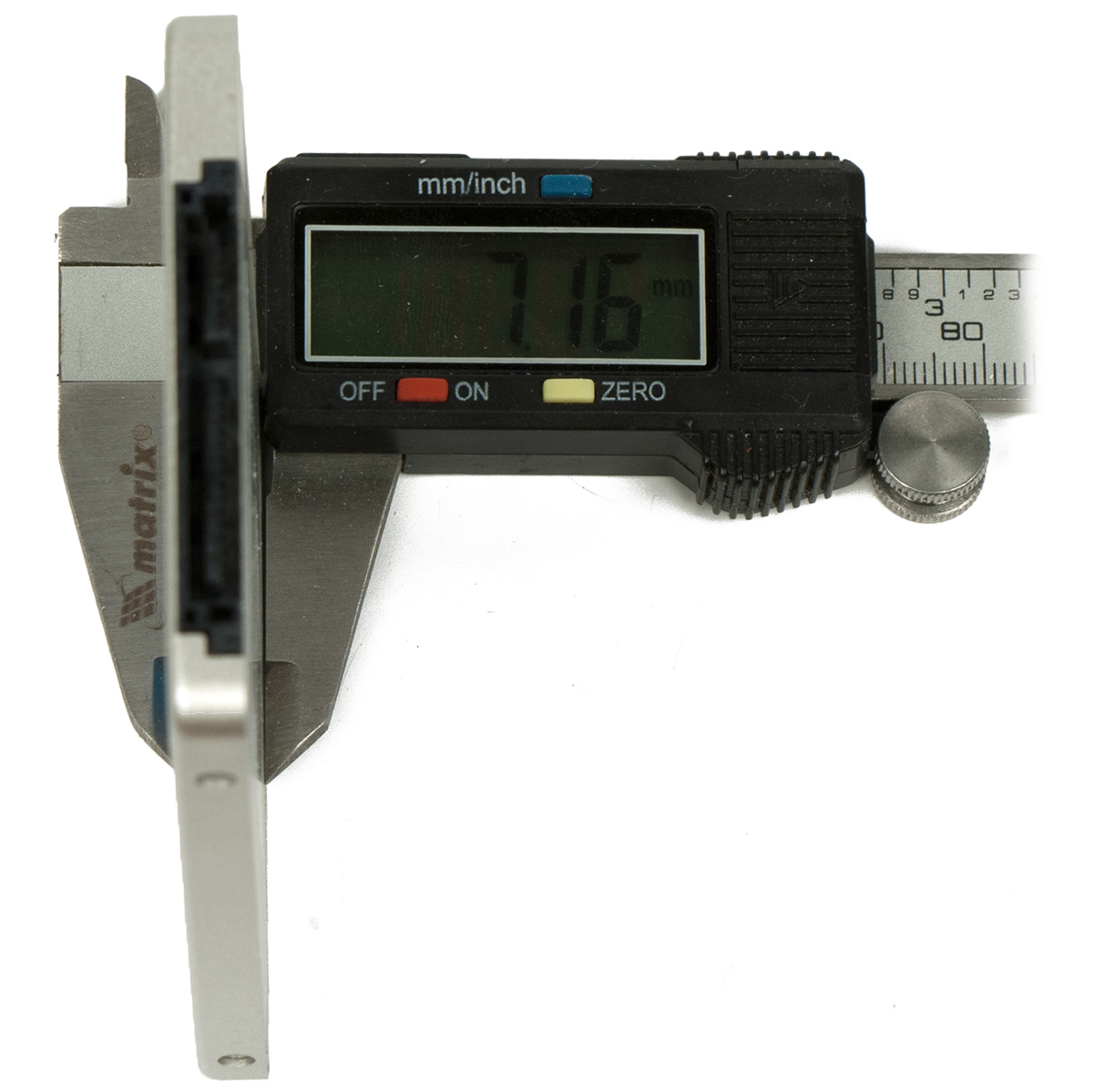
When looking at a printed circuit board, there is an involuntary consideration of the practically possible five millimeters in thickness, because the most "puffy" place on the board is the SATA connector.
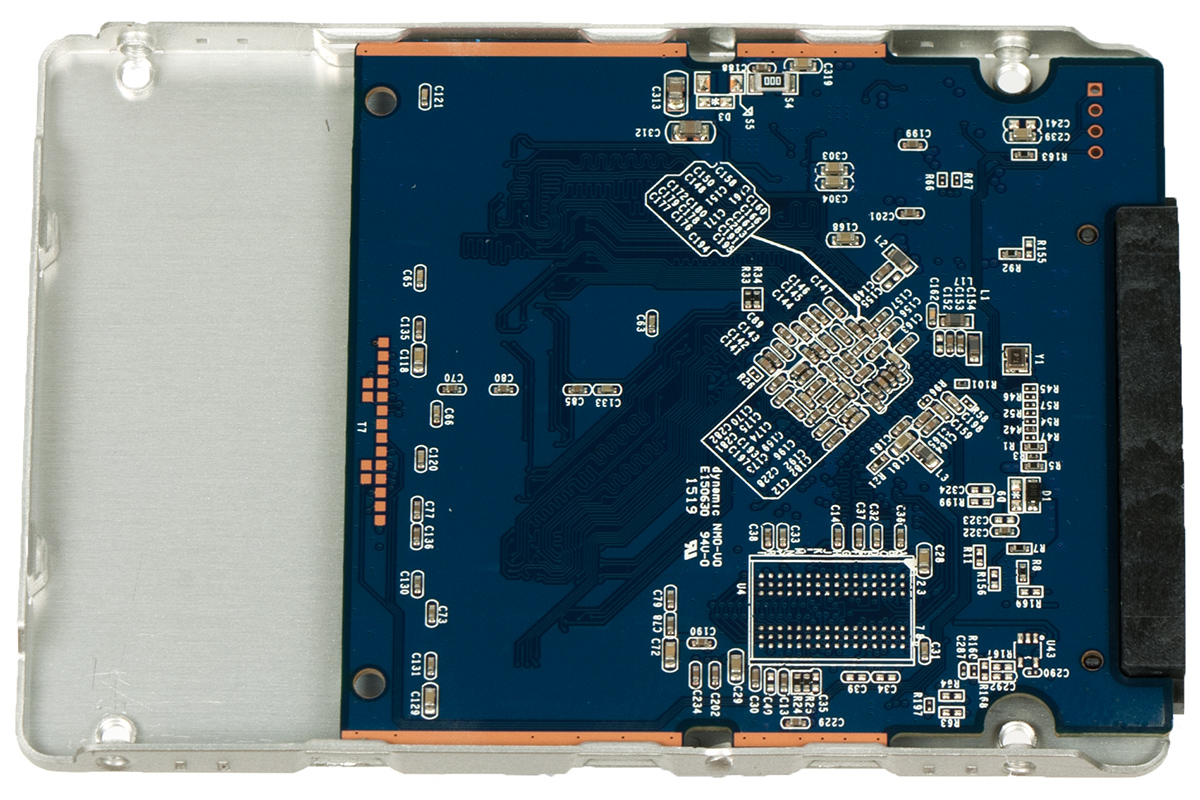
An important feature of the housing design is the snap-on mounting. In order to maximize the cost of production, the manufacturer refused to screw fastening. Difficulties for curious users with snaps will not arise, with proper skill, the halves are quickly separated with a thin blade penknife.
The modest-sized PCB involuntarily raises the question of dimensions: why not shorten the case to 72 mm?
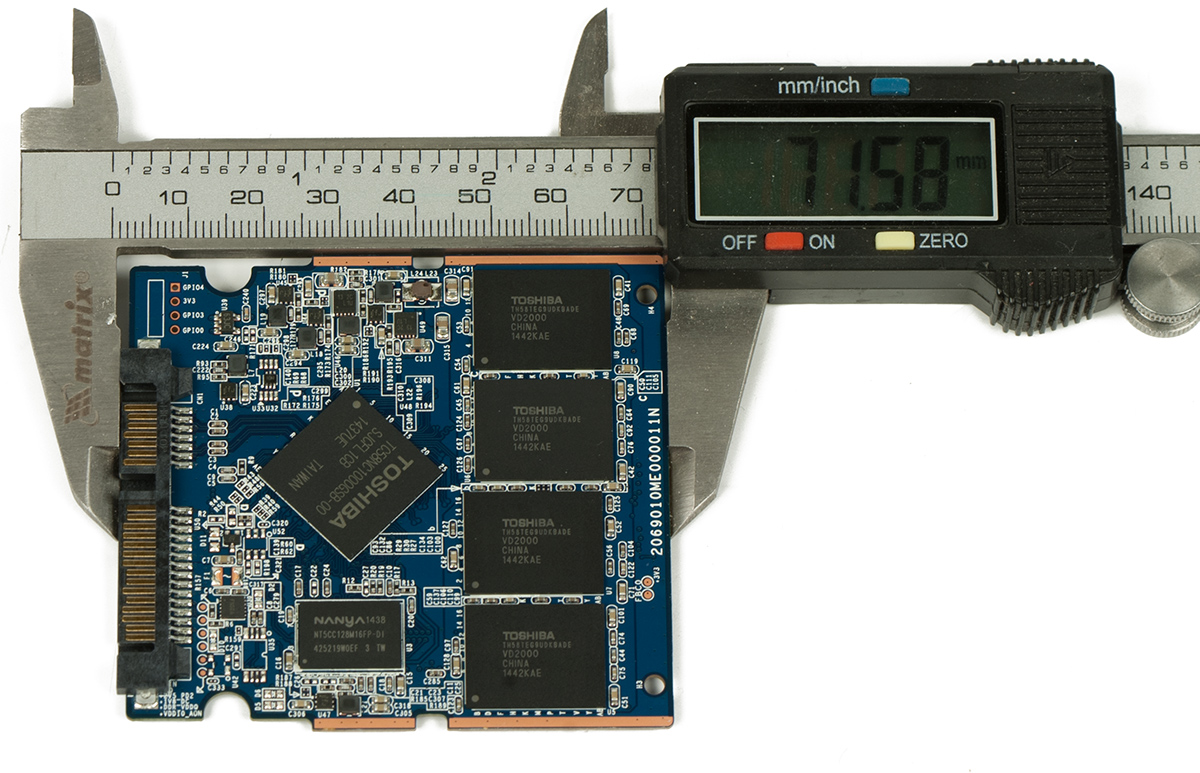
And the material is saved, and the space in vain does not disappear. It may seem that the additional space is reserved for more capacious versions, but no, the printed circuit board is the same for both the 480 GB model and 960 GB, only the volume of the chips changes.
Actually, about the stuffing.
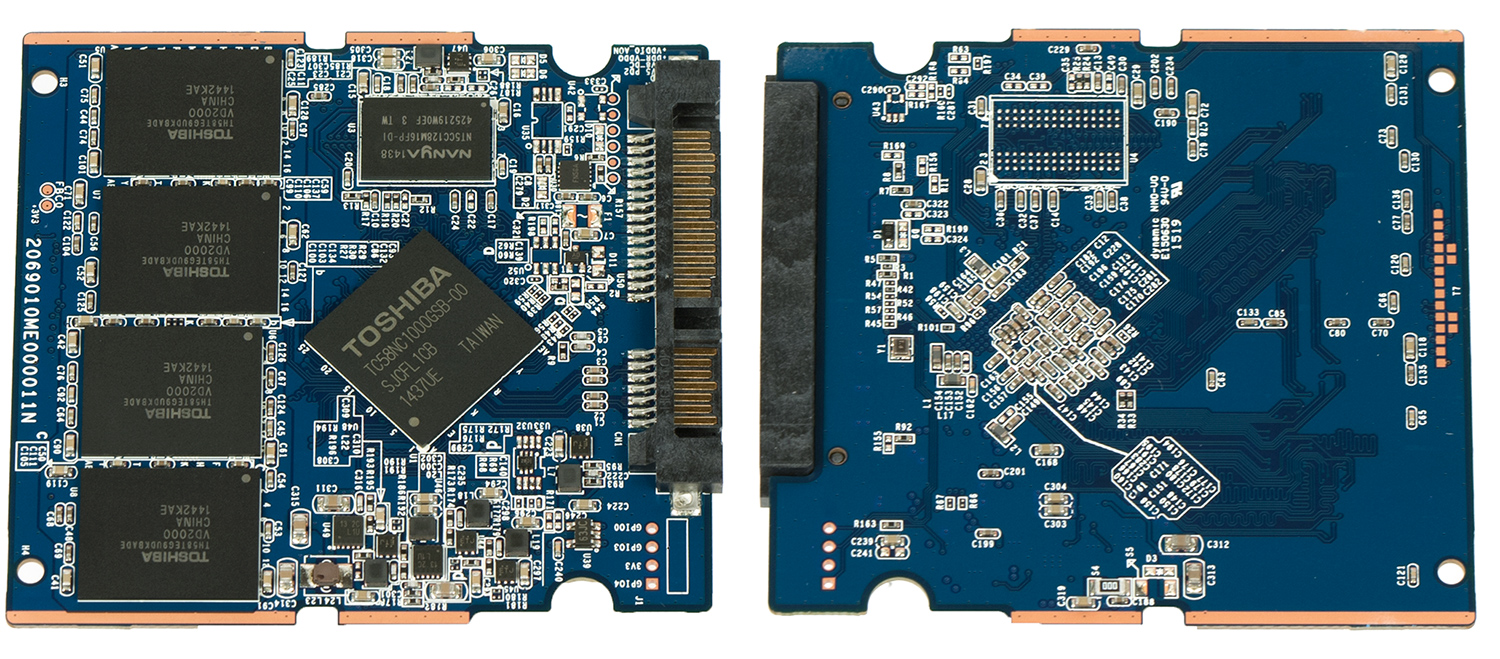
The heart of the drive is the Toshiba TC58NC1000GSB controller, which in the literal sense without a clan or tribe. OCZ itself does not give any reference information to it, and even in the reference table it simply refers to “Toshiba”.

But some observers, bearing in mind the similarity of the Trion 100 printed circuit board to the SmartBuy previously seen in the drive (also, by the way, one of the most cost effective), point to the real manufacturer of the controller - PHISON. Indeed, there are very few differences:
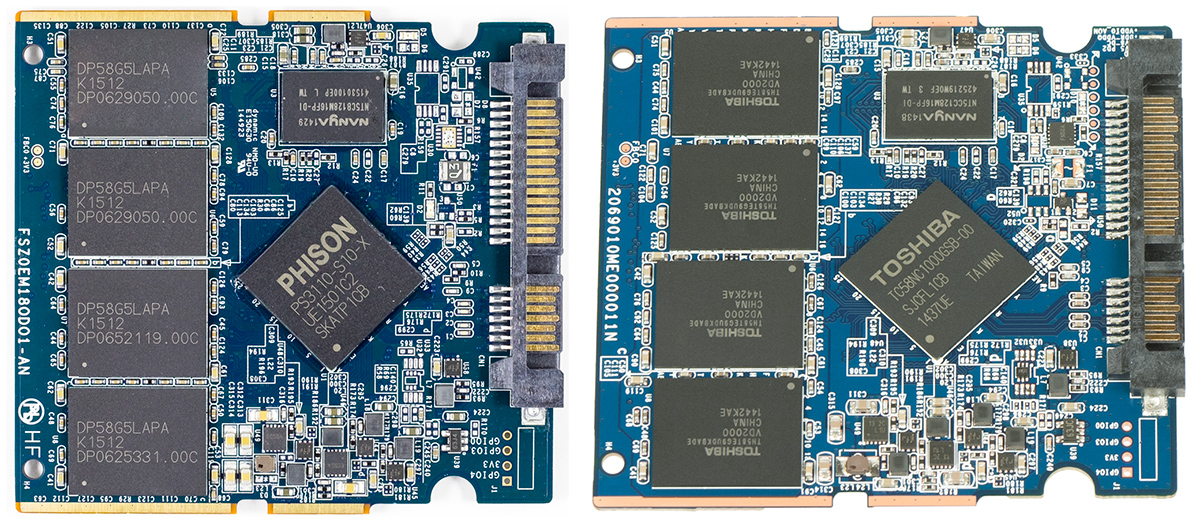
Information about SSD, issued by CrystalDiskInfo, is not replete with details, but a search by the name of the firmware on Google does not bring any special results, everywhere there are only links to Trion.
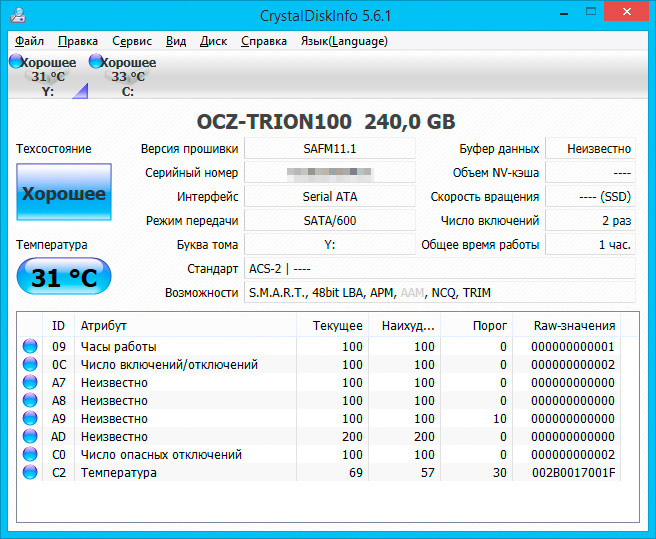
Well, even if this is not a Toshiba product, the main thing is how it will show itself in action.
For data storage, four TLC NAND memory chips with Toshiba TC58TEG9UDKBADE marking, manufactured using the 19 nm process technology, are used. There are no doubts about the origin of the chips, Toshiba has long been known as a manufacturer of FLASH memory, and its market share only in 2014 was more than 20%.
The choice of this type of memory is clear: the use of TLC second-generation memory allows you to reduce the price per gigabyte and not much lose in speed. Theoretically, the capacity of one channel is 400 MB / s, which should be enough for more or less decent speed performance.
The RAM chip is installed above the controller, 256 MB DDR3, labeled Nanya NT5CC128M16FP-DI:
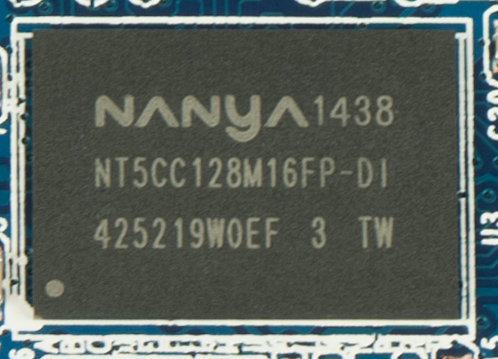
On the reverse side of the board, there is empty space for the second chip, which is installed on the 960 GB model.
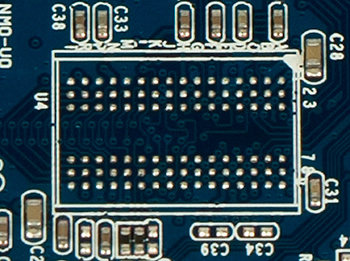
The heating of the electronics during operation is scanty; no microcircuits are required for heat sink. Energy-saving technologies claimed by the manufacturer, and really work ...
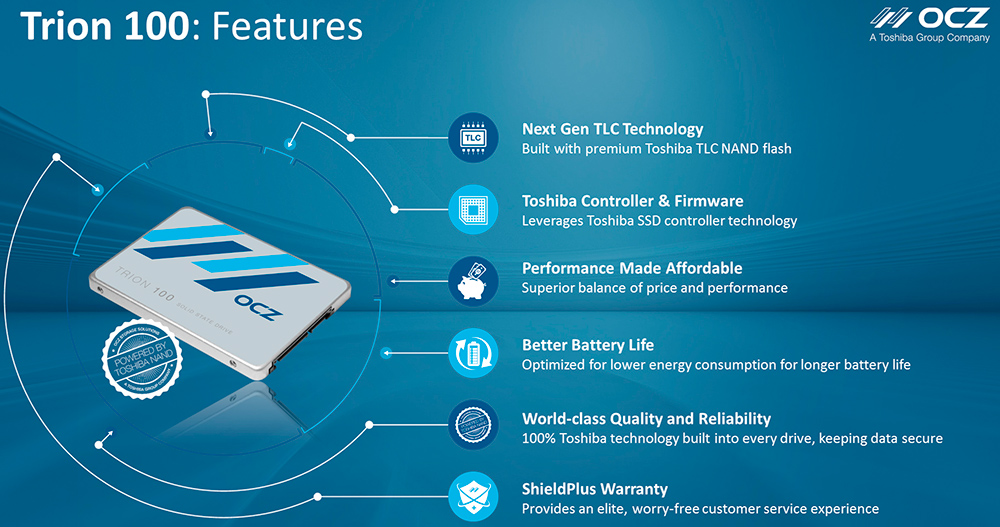
Proprietary SSD utility Guru displays full information about the drive: temperature data, data filling, SMART parameters; You can see the basic system data.

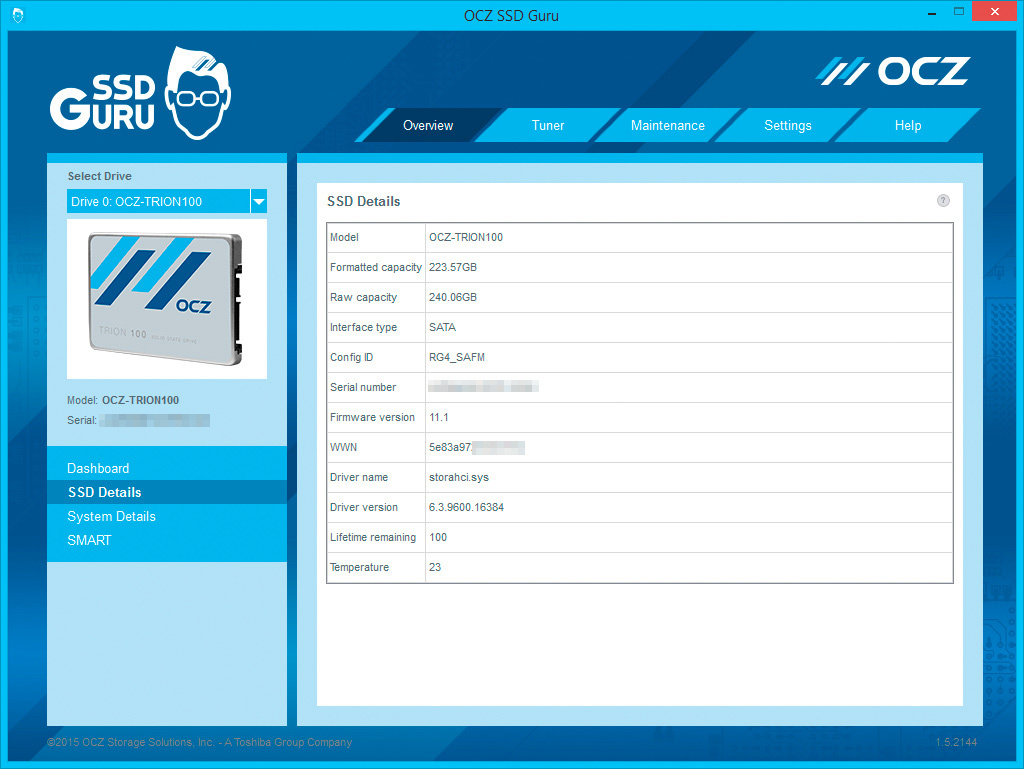
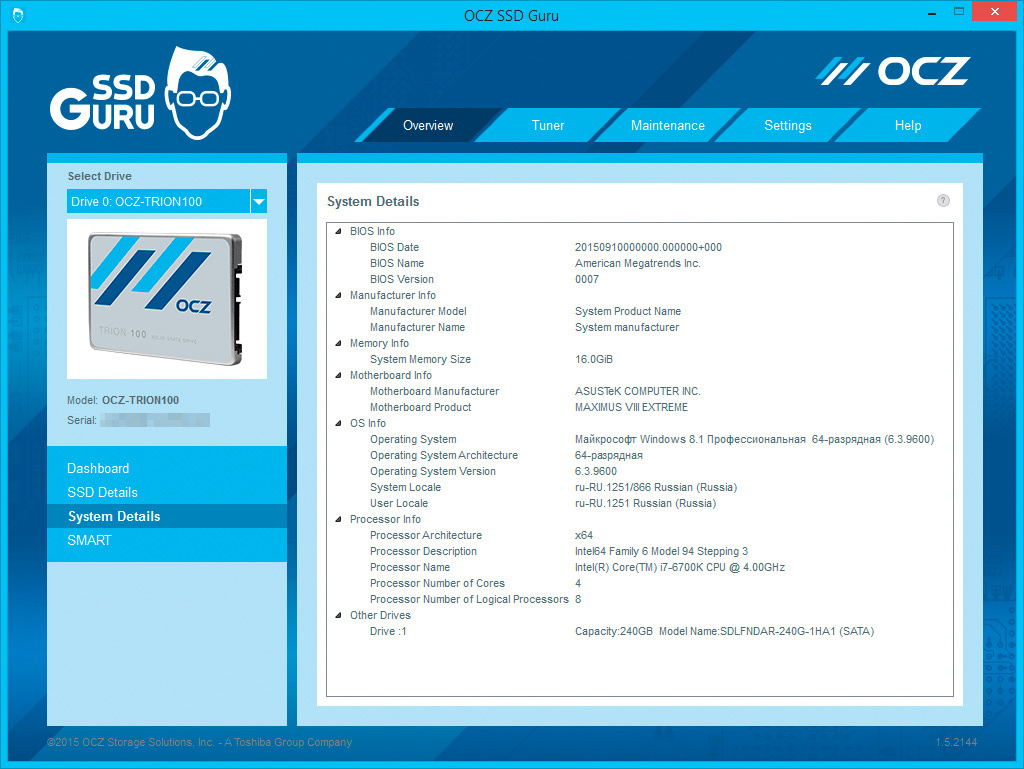
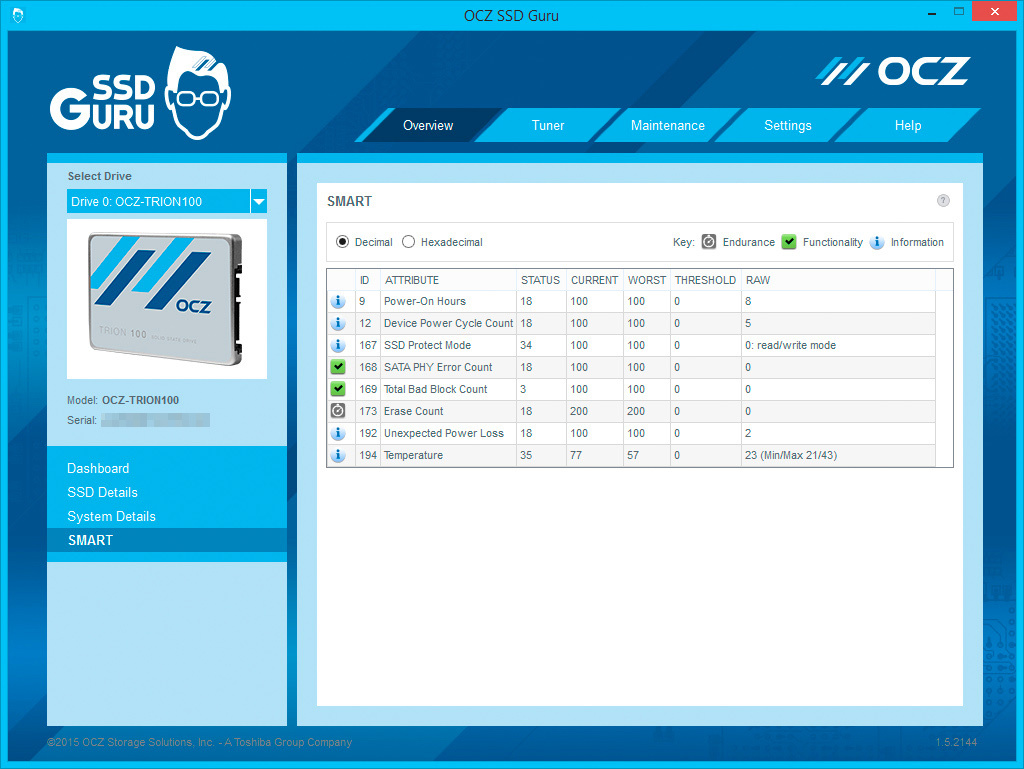
In the “Tuner” section, you can set the “Reserve” area (Overprovisioning), as well as, if necessary, “trigger” the TRIM manually.
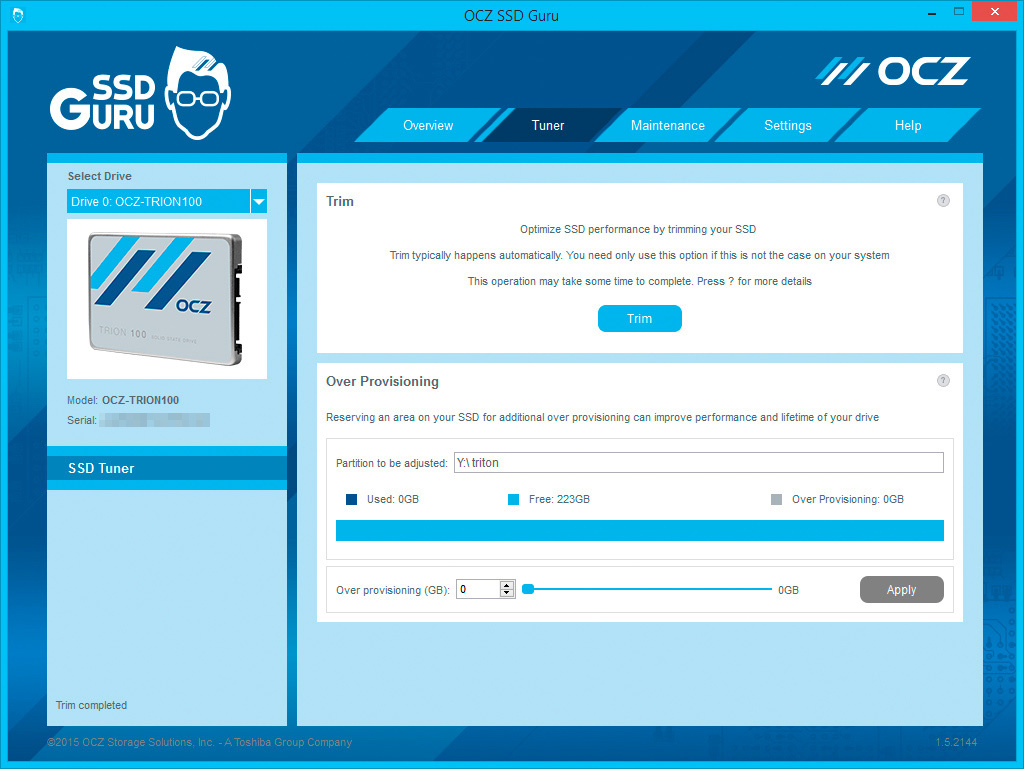
Those wishing to update the firmware or completely clean the drive direct road to the "Maintenance" section.

Additional options for SSD Guru in the "Settings".

Section "Help" is useful curious. All information, however, only in English.
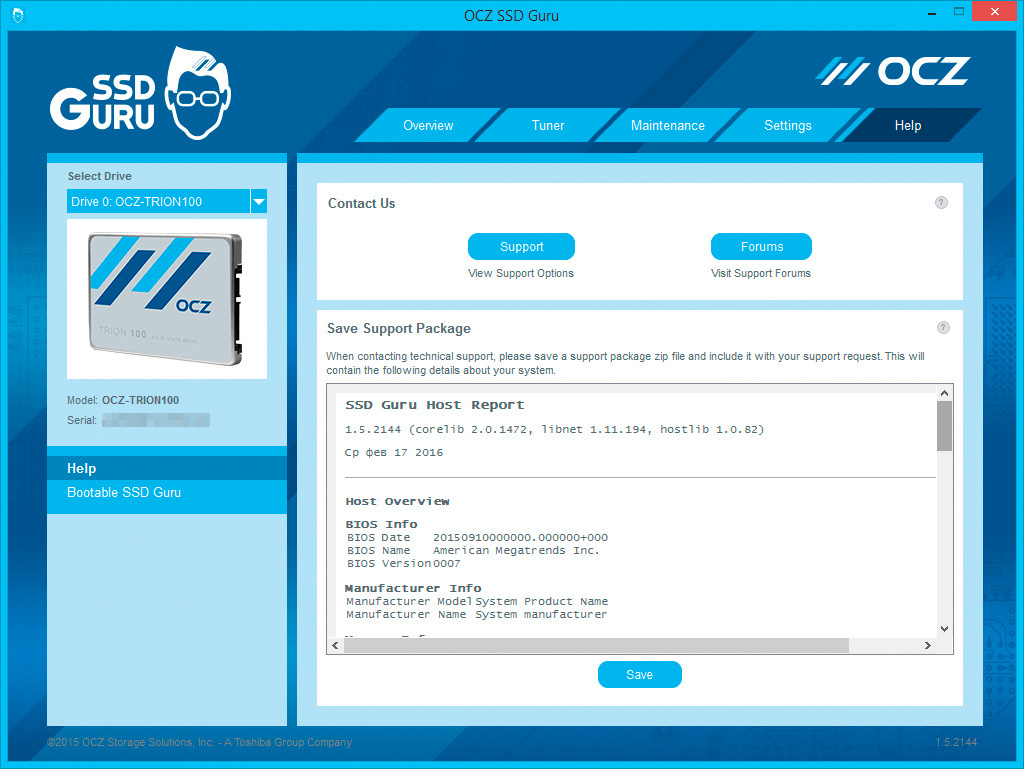
The “Bootable SSD Guru” subsection offers to download the off-line version of the utility from offsite and write it to a USB flash drive for use in case of any problems with the OS.
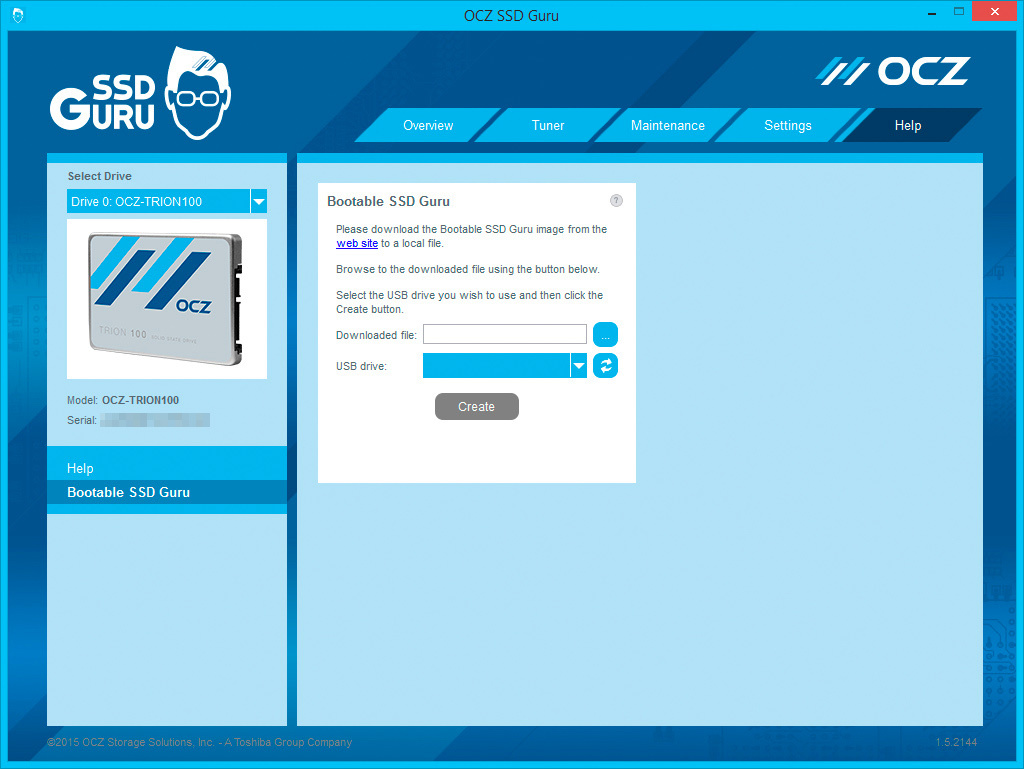
The general opinion about the utility is above average. For a simple user will be a good help in the work; left in Russian translate.
To heighten interest, two other SSDs are introduced into testing: the ADATA SP920SS with a capacity of 256 GB based on the well-known Marvell 88SS9189 controller and 20 nm MLC memory and the Plextor PX-256M6V with a capacity of 256 GB based on the Silicon Motion SM2246EN controller with 15 nm MLC memory. Both drives from another "weight category"; the first can already be considered an old man - more than a year and a half on the market, the second issue of 2015. With their help, let's see how budget Trion approached confidently feeling models in the Middle-End sector.
If anyone could not see the test system config in one of the OCZ Guru screenshots, it is listed in the sidebar.
The operating system has all the necessary tweaks for normal operation and evaluation of disk performance:
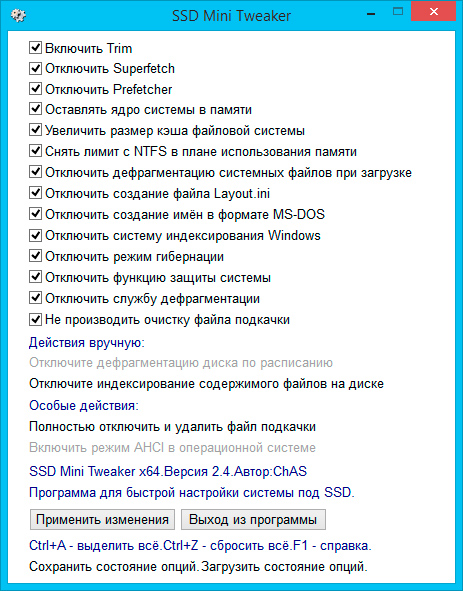
First, according to tradition, CrystalDiskMark and AS SSD Benchmark. Let the readers forgive me for the presented kind of results, but I, having twisted the data obtained in this way and that, I thought that in this case, with a small number of the tested models, the presentation as is the most illustrative of the tables and variegated graphs. Moreover, the interfaces of both programs are well known to many and the eye itself draws the necessary data for comparison.

Trion 100 indicators are great, but what happens if you increase the volume of the task?
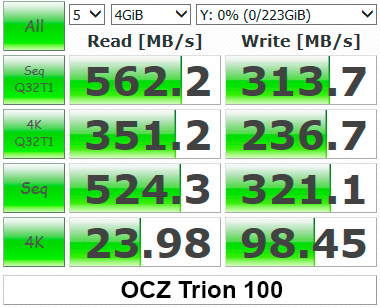
Writing speeds have fallen seriously, while reading performance has not changed much. The fact is that this OCZ drive is able to quickly record small data, about one and a half gigabytes, and after that the write speed drops dramatically. Indirectly, this is evidenced by a ragged recording schedule in the Compression Benchmark test from AS SSD, where the compressible data is intermixed with incompressible.

For real (read - practical) tasks, these “quick and a half gigabytes” can play a decisive role: ordinary work on a PC rarely involves operating with such large amounts of data, especially when it comes to an inexpensive PC that does not require significant performance in serious software packages. A consistent read / write and so normally go even to SandForce.
If you look at the rest of the AS SSD charts, you can clearly see that low recording speeds with a significant queue depth for the Trion 100 practically did not affect the Game, ISO and Program test results, in which the corresponding patterns with several or multiple files of different sizes are played.
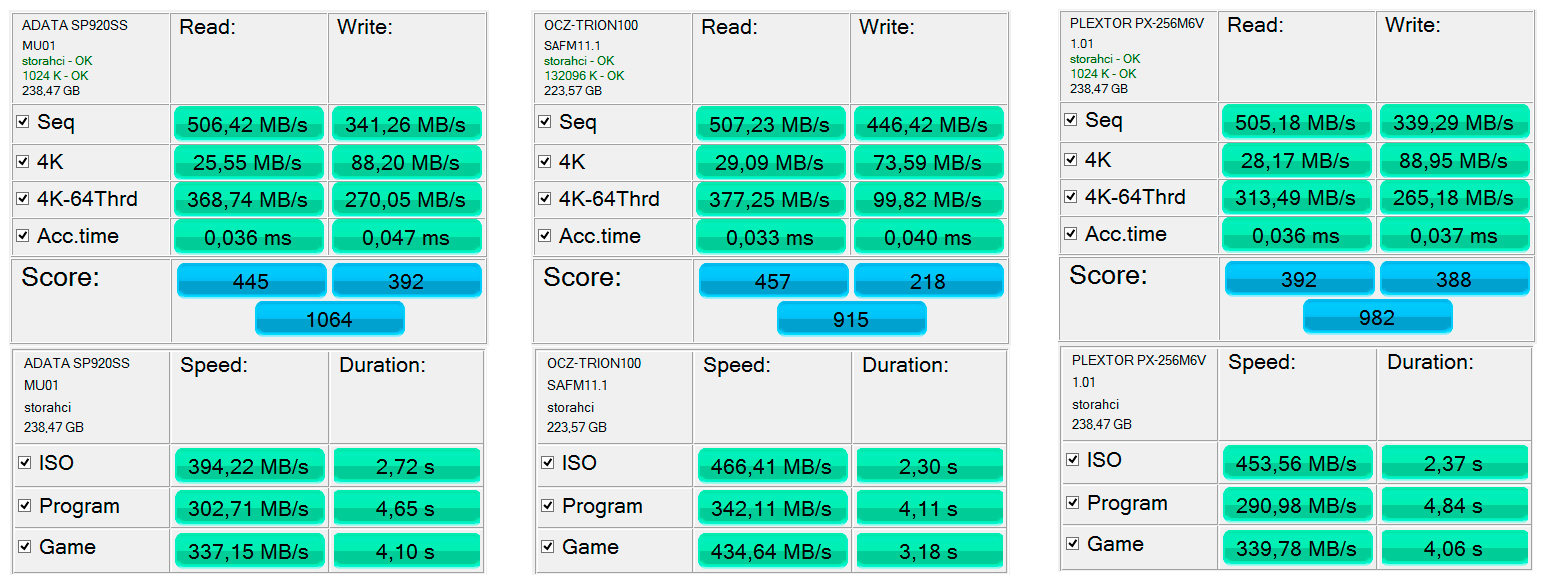
Drives with more “serious” controllers show greater stability of parameters, whereas Trion 100 indicators depend not only on the type of operation and the type of data, but also on the size of the task.
The confirmation of this will be the results of the PCMark 8 Storage benchmark:
Of course, this review does not draw upon a comprehensive study of the possibilities and nuances of the OCZ Trion 100 behavior, however, the presented data is enough for two conclusions: 1. The Trion 100 is quite suitable for replacing HDD as a system disk in budget PCs and other “consumer” systems, because 2. Toshiba TC58NC1000GSB (aka Phison PS3110) is not at all the same as SandForce, but much better. Yes, in some places you have to go for tricks (the very 1.5 gigabytes in how-s_SLC mode), and the second-generation Toggle TLC is much faster, but the result is obvious: the drive was adapted for fast execution of everyday tasks and made attractive for an ordinary buyer by price.
The current company OCZ (more precisely, Toshiba's OCZ), like the previous company OCZ, considers the market one of the main drivers for itself, and therefore regularly updates its product line. Not so long ago (by universal standards), the budget model OCZ Trion entered the market in four varieties - 120, 240, 480 and 960 gigabytes.

At prices option interesting: 3800, 6000, 12000 and 21000 rubles, respectively. At the time of writing this review (February 17), this is one of the cheapest SSD form factor 2.5 ″. The most profitable model is 240 GB: the most current volume (the golden mean between the toad and the needs), the second most expensive in its class. An excellent reason to consider it in more detail.
')
A Trion 100 drive (model TRN100-25SAT3-240G) is supplied in a thin cardboard box; I would even call it an envelope for a small box stiffness.

Inside a transparent plastic holder, a brief accompanying abstract and nothing more. No frame adapter to be installed in the 3.5 "compartment, no fastening screws.
Saving on accessories is justified when the struggle is for every cent. After assembling the case, there are always some screws with a suitable thread, and even without an adapter you can do.
The SSD case is not made of plastic (as in some other budget drives), but of extruded aluminum with a thickness of 0.8 mm, which, among other things, protects the electronic filling from mechanical damage. On the front side of the label indicating the model ...

... On the back - a sticker with other useful information.

The thickness of the Trion 100 is standard - seven millimeters.

Autopsy revealed
When looking at a printed circuit board, there is an involuntary consideration of the practically possible five millimeters in thickness, because the most "puffy" place on the board is the SATA connector.

An important feature of the housing design is the snap-on mounting. In order to maximize the cost of production, the manufacturer refused to screw fastening. Difficulties for curious users with snaps will not arise, with proper skill, the halves are quickly separated with a thin blade penknife.
The modest-sized PCB involuntarily raises the question of dimensions: why not shorten the case to 72 mm?

And the material is saved, and the space in vain does not disappear. It may seem that the additional space is reserved for more capacious versions, but no, the printed circuit board is the same for both the 480 GB model and 960 GB, only the volume of the chips changes.
Actually, about the stuffing.

The heart of the drive is the Toshiba TC58NC1000GSB controller, which in the literal sense without a clan or tribe. OCZ itself does not give any reference information to it, and even in the reference table it simply refers to “Toshiba”.

But some observers, bearing in mind the similarity of the Trion 100 printed circuit board to the SmartBuy previously seen in the drive (also, by the way, one of the most cost effective), point to the real manufacturer of the controller - PHISON. Indeed, there are very few differences:

Information about SSD, issued by CrystalDiskInfo, is not replete with details, but a search by the name of the firmware on Google does not bring any special results, everywhere there are only links to Trion.

Well, even if this is not a Toshiba product, the main thing is how it will show itself in action.
For data storage, four TLC NAND memory chips with Toshiba TC58TEG9UDKBADE marking, manufactured using the 19 nm process technology, are used. There are no doubts about the origin of the chips, Toshiba has long been known as a manufacturer of FLASH memory, and its market share only in 2014 was more than 20%.
The choice of this type of memory is clear: the use of TLC second-generation memory allows you to reduce the price per gigabyte and not much lose in speed. Theoretically, the capacity of one channel is 400 MB / s, which should be enough for more or less decent speed performance.
The RAM chip is installed above the controller, 256 MB DDR3, labeled Nanya NT5CC128M16FP-DI:

On the reverse side of the board, there is empty space for the second chip, which is installed on the 960 GB model.

The heating of the electronics during operation is scanty; no microcircuits are required for heat sink. Energy-saving technologies claimed by the manufacturer, and really work ...

Proprietary SSD utility Guru displays full information about the drive: temperature data, data filling, SMART parameters; You can see the basic system data.




In the “Tuner” section, you can set the “Reserve” area (Overprovisioning), as well as, if necessary, “trigger” the TRIM manually.

Those wishing to update the firmware or completely clean the drive direct road to the "Maintenance" section.

Additional options for SSD Guru in the "Settings".

Section "Help" is useful curious. All information, however, only in English.

The “Bootable SSD Guru” subsection offers to download the off-line version of the utility from offsite and write it to a USB flash drive for use in case of any problems with the OS.

The general opinion about the utility is above average. For a simple user will be a good help in the work; left in Russian translate.
Performance evaluation
To heighten interest, two other SSDs are introduced into testing: the ADATA SP920SS with a capacity of 256 GB based on the well-known Marvell 88SS9189 controller and 20 nm MLC memory and the Plextor PX-256M6V with a capacity of 256 GB based on the Silicon Motion SM2246EN controller with 15 nm MLC memory. Both drives from another "weight category"; the first can already be considered an old man - more than a year and a half on the market, the second issue of 2015. With their help, let's see how budget Trion approached confidently feeling models in the Middle-End sector.
If anyone could not see the test system config in one of the OCZ Guru screenshots, it is listed in the sidebar.
| CPU | Intel Core i7-6700K |
| Motherboard | ASUS Maximus VIII Extreme |
| RAM | 2x 8 GB DDR4-2133 |
| Drive (system) | SanDisk SSD 240 GB |
| Video card | ASUS ARES II |
| Power Supply | Enermax Triathlor 550 W |
The operating system has all the necessary tweaks for normal operation and evaluation of disk performance:

First, according to tradition, CrystalDiskMark and AS SSD Benchmark. Let the readers forgive me for the presented kind of results, but I, having twisted the data obtained in this way and that, I thought that in this case, with a small number of the tested models, the presentation as is the most illustrative of the tables and variegated graphs. Moreover, the interfaces of both programs are well known to many and the eye itself draws the necessary data for comparison.

Trion 100 indicators are great, but what happens if you increase the volume of the task?

Writing speeds have fallen seriously, while reading performance has not changed much. The fact is that this OCZ drive is able to quickly record small data, about one and a half gigabytes, and after that the write speed drops dramatically. Indirectly, this is evidenced by a ragged recording schedule in the Compression Benchmark test from AS SSD, where the compressible data is intermixed with incompressible.

For real (read - practical) tasks, these “quick and a half gigabytes” can play a decisive role: ordinary work on a PC rarely involves operating with such large amounts of data, especially when it comes to an inexpensive PC that does not require significant performance in serious software packages. A consistent read / write and so normally go even to SandForce.
If you look at the rest of the AS SSD charts, you can clearly see that low recording speeds with a significant queue depth for the Trion 100 practically did not affect the Game, ISO and Program test results, in which the corresponding patterns with several or multiple files of different sizes are played.

Drives with more “serious” controllers show greater stability of parameters, whereas Trion 100 indicators depend not only on the type of operation and the type of data, but also on the size of the task.
The confirmation of this will be the results of the PCMark 8 Storage benchmark:
| ADATA SP920SS | OCZ Trion 100 | Plextor M6V | |
| Storage score | 4924 | 4817 | 4909 |
| World of Warcraft, sec | 58,8 | 60 | 59.1 |
| Battlefield 3, s | 134.3 | 136.3 | 134.7 |
| Adobe Photoshop Light, sec | 115.4 | 117.4 | 115.5 |
| Adobe Photoshop Heavy, sec | 363.7 | 368.9 | 364 |
| Adobe InDesign, sec | 58.3 | 61.1 | 58.5 |
| Adobe After Effects, sec | 71.1 | 72.2 | 71.2 |
| Adobe Illustrator, sec | 72.6 | 73.7 | 72.8 |
| Microsoft Word, sec | 28.5 | 28,8 | 28.5 |
| Microsoft Excell, sec | 9.3 | 9.6 | 9.4 |
| Microsoft PowerPoint, sec | 9.3 | 9.6 | 9.3 |
| Storage bandwidth, MB / s | 277 | 171 | 251 |
Of course, this review does not draw upon a comprehensive study of the possibilities and nuances of the OCZ Trion 100 behavior, however, the presented data is enough for two conclusions: 1. The Trion 100 is quite suitable for replacing HDD as a system disk in budget PCs and other “consumer” systems, because 2. Toshiba TC58NC1000GSB (aka Phison PS3110) is not at all the same as SandForce, but much better. Yes, in some places you have to go for tricks (the very 1.5 gigabytes in how-s_SLC mode), and the second-generation Toggle TLC is much faster, but the result is obvious: the drive was adapted for fast execution of everyday tasks and made attractive for an ordinary buyer by price.
Source: https://habr.com/ru/post/390833/
All Articles